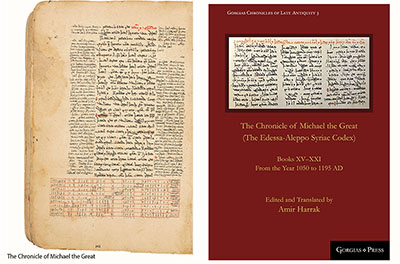Michael the Great was patriarch of the Syriac Orthodox Church from 1166 to 1199 CE, when he wrote his voluminous world Chronicle in three parts in one volume: ecclesiastical history, political history, and ‘natural history,’ in which he discussed celestial observations, earthquake reports, and meteorological conditions. He also included synchronistic tables in which he placed dates and names of ruling dynasties, including Turkish, Arab Caliphal, Armenian, Frankish and Greek, using different computation systems: Seleucid, Nativity, the Olympiad and the Hegira, with the latter always associated with caliphal rulers.
Professor Amir Harrak published a Syriac edition and English translation of the latter Books XV to XXI, dated to the year 1050 to 1195, using for the first time ever a 16th century copy found in Aleppo in Syria. This manuscript was digitized by the Hill Museum and Manuscripts Library, Minnesota, USA, by its executive director, Father Columba Steward, OSB, and was published by Gorgias Press, USA. Professor Harrak’s book appeared in 2019 in nearly 500 pages.

(Image courtesy of Professor Harrak)
The Chronicle of Michael the Great is a major source on the history of the Near East from the biblical account of the Creation to the end of the 12th century CE. For the latter century, the patriarch discussed events detailing the progressive expansion of the Turks in Anatolia, the end of the Islamic Caliphate, the advent of the Crusaders, and other historical happenings.
Scientists in NASA, the American National Aeronautics and Space Administration, are very interested in the Chronicle of Michael the Great as it discusses topics of their own interest, including comets and other celestial appearances, volcano eruptions, some obscuring the Near East and Europe for long days, periodic eclipses, and drastic climate changes. A Belgian psychologist, Lieven Verbrugge, asked the question 'Why would NASA of the 21st century be interested in a book composed some 1000 years ago?'. You will find the answer in the following YouTube link.


